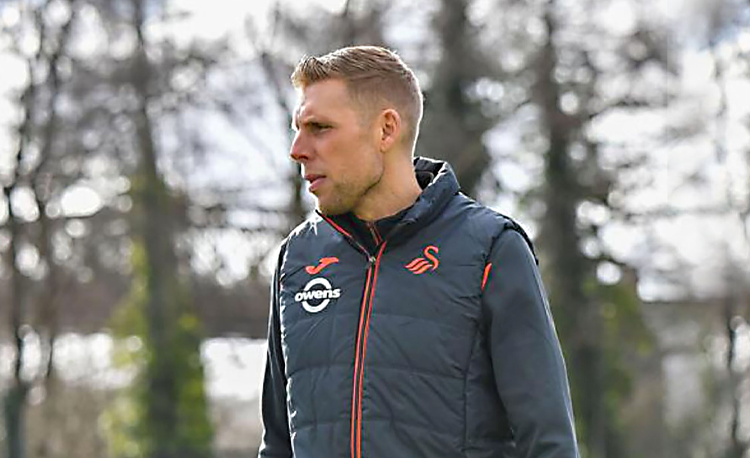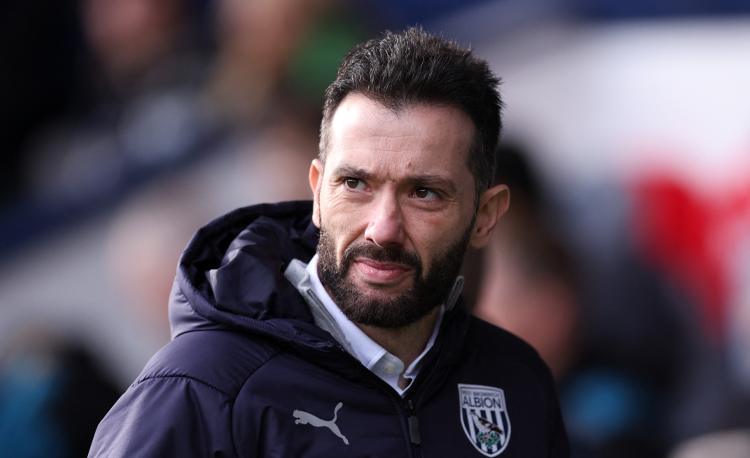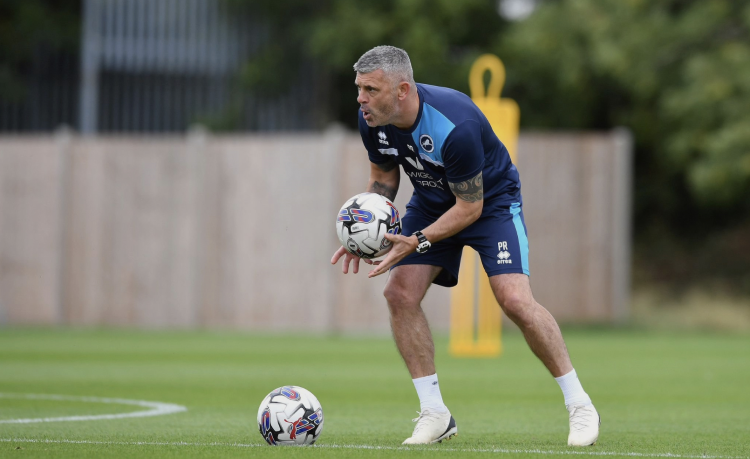You are viewing 1 of your 1 free articles
Wing play
Wing play can be the winning difference for teams on match days. This session works on giving players the ability to make quick decisions to transfer the ball to the wings and to support the movement created by that decision.
| Area | Up to full pitch |
| Equipment | Balls, bibs, cones, poles, 4 small goals, 2 full size goals |
| No. of Players | Up to 20 players + 2 goalkeepers |
| Session Time | Total: 65mins, Warm-up: 15mins, 4v3: 15mins, 9v9: 15mins, 11v11: 20mins |
In modern soccer, the creation and usage of space while in possession of the ball is vital for successful attacking actions. Due to the ever-changing dynamic situations, it is extremely important that players have the ability to make quick decisions to transfer the ball to the wings and to support the movement created by that decision. Often one winger will have more space than the other, so players will need the vision to switch play from one side of the pitch to the other.
The use of overloads is important for the success of the session and they create more match-like scenarios for players to solve. Modern players have all the tools to score in a variety of ways but practice is vital to ensuring they can play at a quick tempo when the opportunities present themselves in a match.
Wing play can be the winning difference for teams on match days.
What do I get the players to do?
Warm-up
Set up in half a pitch as shown [1], using 10 players in two groups of five, with both groups performing the drill at the same time but starting from opposite corners.
1
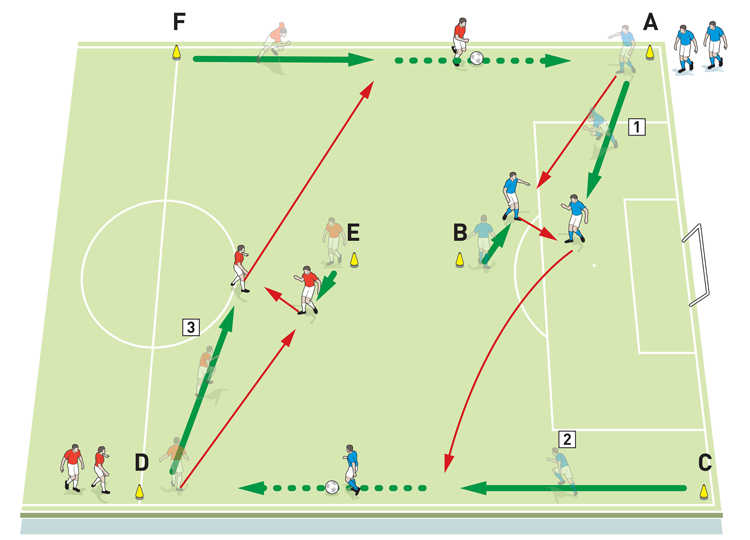
2. Player C moves on the first pass of player A and receives the ball on the run before dribbling down the wing to D and joining the queue
3. The same sequence has been run from the other end, beginning with player D
At one end play starts with a pass from the player at A to the player at B. Player A then runs for a lay-off from B, and passes to player C, who has started moving on the first pass of player A and who now receives the ball on the run. After receiving the ball, player C dribbles down the wing to the player at D, who begins the same sequence with the players at E and F.
Player A has now taken the place of B; player B has replaced C; player C has joined the back of the queue at D; and a new player with a new ball has started a new cycle from position A.
What do I get the players to do next?
4v3 +2 neutral wingers
This is a drill that highlights the necessity of a good defending shape, especially when down in numbers and the attackers have an overload. For the defending team this activity is about regaining the ball, while for the possession team it’s focused on using the wingers as support when attacking.
Set up two 20x30yard boxes separated by a 5-yard neutral centre zone, as shown [2a]. We’re using 10 players with two teams of four, one starting in each end zone, and two neutral wingers, one on each touchline. The team in possession has four players in their end zone and, playing with no more than three touches, must try to make seven consecutive passes using the help of the neutral wingers, who are limited to one-touch. If they complete seven passes, the possession team scores a point.
2a
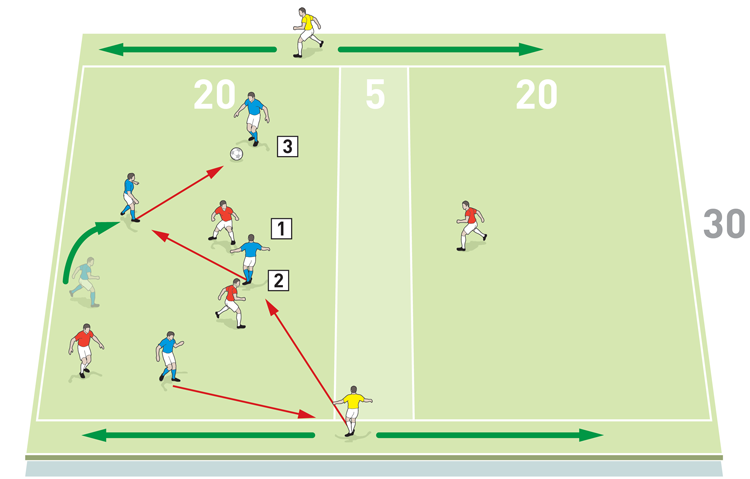
2. The red pressing team must leave one player in their end zone and send three to win the ball in the opposition end zone
3. The passing players should have no more than three touches
To stop them scoring, the pressing team sends three players into the opposition end zone to try to win the ball and leaves one player in their end zone. If the pressing team wins the ball, as shown [2b], they must pass immediately to their team mate in the other end zone and follow the ball, forming a new possession team. The team that lost the ball sends in three players to try to regain possession again.
2b

2. The blue team that lost the ball sends three players into the other end zone to try to win the ball
3. The other reds join their team mate to create a new possession team
If the ball goes out of play, the coach passes to the lone player in the end zone and play continues. Change the neutrals regularly. Play five rounds of 90 seconds with two minutes of recovery time in between.
How do I progress the session?
9v9 +2 neutrals
We now progress the session towards a game situation with an activity where the management of the ball while in possession can “open” the wing to help create scoring chances.
Set up between the Ds of the two penalty areas, with four small goals in the corners and pole gates in the centre of the pitch, as shown [3].
We’re using 20 players, split into two teams of nine plus two neutral players, who help the team in possession. Players have three touches.
3
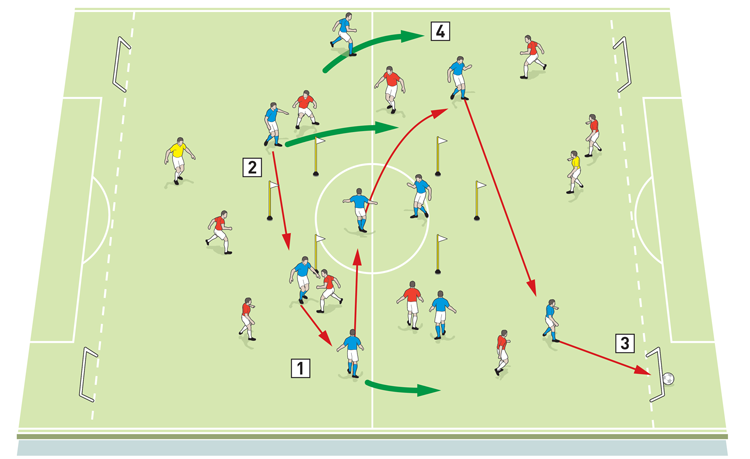
2. Teams can also score by passing to a team mate through the pole gates
3. The third way teams can score is in the small goals
When a player scores in a small goal, all his team mates must have moved into the attacking half or the goal doesn’t count
The team in possession can score a point by passing to a team mate through one of the pole gates, or by making seven consecutive passes in their own half of the pitch. Teams can also score in one of the small goals. When the ball goes in the small goal, each member of the attacking team must have moved into the attacking half of the pitch or the goal does not count.
The scoring options allow players to attract the opponent to one side and immediately switch the point of attack, using the space on the other side with a short-short combination. The two neutral players guarantee an overload for the team in possession.
Play for three rounds of four minutes, with one minute of recovery between.
How would you put this into a game situation?
11v11 + wide channels
This is the last preparatory game we would run before the regular 11v11 match and the main priority for the team in attack will be using the wings as much as possible.
We set up between the two penalty areas with a goal at each end and with a central area coned off at the width of the penalty area, creating two channels on the wings, as shown [4].
4
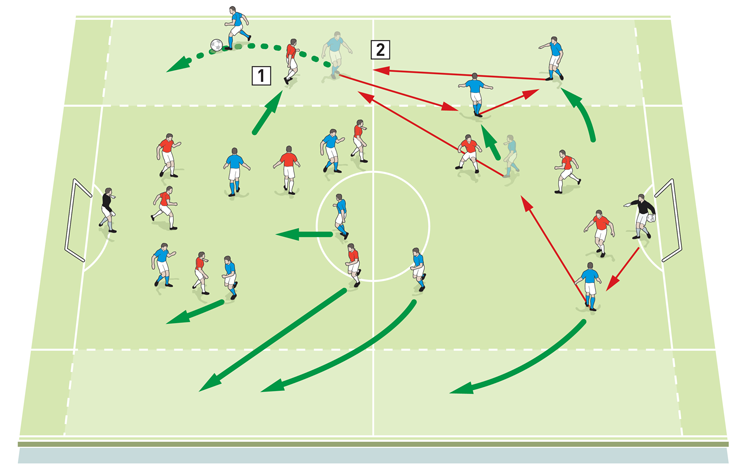
2. Blue attackers move the ball in and out of the channel to help beat the red defender
Play 11v11 including goalkeepers, but if an attacker receives the ball in one of the two wide channels, only one defender can go in and challenge for the ball. The main objective is to use the channels for crossing the ball or dribbling into the attacking zone using 2v1 overloads in the channel.
Play three blocks of five minutes with two minutes of recovery time between. But if we decide to play a regular 11v11 game at the end of the session, we would only play two rounds of four minutes of this activity.
Related Files
Editor's Picks
Using the goalkeeper in build-up play
Pressing principles
Intensive boxes drill with goals
Penetrating the final third
Creating and finishing
My philosophy
Pressing initiation
Compact team movement
Defensive organisation
Coaches' Testimonials

Alan Pardew

Arsène Wenger

Brendan Rodgers

Carlos Carvalhal

José Mourinho

Jürgen Klopp

Pep Guardiola

Roy Hodgson

Sir Alex Ferguson

Steven Gerrard
Coaches' Testimonials

Gerald Kearney, Downtown Las Vegas Soccer Club

Paul Butler, Florida, USA

Rick Shields, Springboro, USA

Tony Green, Pierrefonds Titans, Quebec, Canada
Join the world's leading coaches and managers and discover for yourself one of the best kept secrets in coaching. No other training tool on the planet is written or read by the calibre of names you’ll find in Elite Soccer.
In a recent survey 92% of subscribers said Elite Soccer makes them more confident, 89% said it makes them a more effective coach and 91% said it makes them more inspired.
Get Monthly Inspiration
All the latest techniques and approaches
Since 2010 Elite Soccer has given subscribers exclusive insight into the training ground practices of the world’s best coaches. Published in partnership with the League Managers Association we have unparalleled access to the leading lights in the English leagues, as well as a host of international managers.
Elite Soccer exclusively features sessions written by the coaches themselves. There are no observed sessions and no sessions “in the style of”, just first-hand advice delivered direct to you from the coach.





